10 things you should and shouldn't do in the gym
08/28/2002
Furci Home / Fitness Channel / Bullz-Eye Home
1. You shouldn't work
your abs everyday.
Here it is a few months from the year 2003, and people still believe the more
they work their abs the better their abs will look. Here's a little hint: ab
work has almost nothing to do with the way your abs look. In fact, for most,
it has nothing to do with it. Working your abs will not give you a six-pack,
period. Below is a picture taken after winning the overall title at a bodybuilding
contest. Not one minute of ab work was done in three years up to that show. And
minimal ab work was done previous to that.
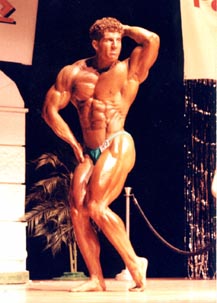
I found that working my abs in a traditional manner of one to two times per week
increased the size of my abs without decreasing the amount of fat. The last thing
I want is a thicker midsection. As I would diet up and down for shows I would
find that even though my ab work remained constant my midsection still got fat
in the off season. It became very apparent that diet is the single most contributing
factor to a set of washboard abs.
About a year after that picture above was taken, I began to develop some minor
lower back problems. I lieu of this problem I began to train my core for functional
strength and flexibility. This can be done with a variety of exercises, preferably
on a stability ball. I now work my abs once every eight to 10 days using two
to three exercises for two sets of 12 to 15 reps each.
2.
You should keep
a training log.
Your successes and failures need to be constantly monitored. Record your daily
training sessions. Keep track of the amount of weight and the number of repetitions
for each set. Record how a particular exercise or workout felt. Did you feel
strong like bull or did you feel like the guy on TV who's a flaming interior
designer? Nothing against interior designers, but "jeez-oh-man," this
guy needs some testosterone replacement therapy.
Anyway, there are some guidelines to use when training, but we all will respond
a little differently. You need to keep records so you can see what works and
what doesn't work for you. You are bound to make wrong turns on your way toward
your goals. It is vital to your success that you do not make those same wrong
turns more than once. Making the same mistakes multiple times will not only slow
your progress but also, in many cases, halt it all together. The road to improving
your physique is too long and complicated to commit to memory.
Think of your record keeping as making a map of your journey. The best way to
get to where you're going is to know where you've been.
3. You shouldn't use
the pull-down machine like a rowing machine.
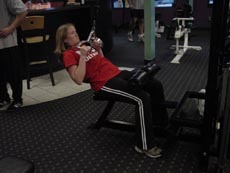
When I see somebody using a pull-down machine similar to the above pictures,
I think to myself, "What an idiot." Most people who perform a pull
down like a row do so because they can use the momentum of their body to move
more weight. Instead of leaving their egos at the door and training correctly,
which results in a better overall growth stimulus, they throw the weight to impress
others using their erectors, glutes and hams.
If you want a bigger, thicker back, perform the pull-down exercise with 100%
intensity, keeping your back in a slightly arched position like below.
The picture on the right is an example of what proper exercise technique did
for me.
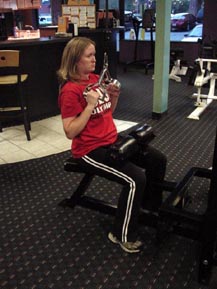
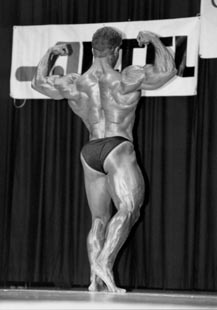
4. You should keep
your protein intake high.
I know, I know, it's going to hurt your kidneys and liver. Whatever! I challenge
anyone to produce one shred of evidence that concludes eating a diet high in
protein will be hazardous to your health. It won't happen because there is not
one study that shows a high protein diet is dangerous for a healthy individual.
But as I've stated in earlier articles, you will find a mound of evidence supporting
higher protein diets.
Protein repairs and maintains everything in our bodies from muscles to hormones.
Amino acids, which proteins are made of, are essential to life, essential meaning
we have to ingest them because our bodies cannot manufacture them. If your protein
intake is too low, your body will get the amino acids it needs from muscle tissue.
This is the kiss of death for anyone trying to improve his or her physique.
Why anyone would consciously eat a diet low in protein is beyond me. There are
two things that begin with the letter "p" that I would never cut back
on and one of them is protein. I love that line. Try to get at least one gram
of protein per pound of body weight. However, if you're training intensely (which
is how you should train) you should consume upwards of 1.5 to two grams/lb of
body weight.
5.
You shouldn't eat a diet high
in carbohydrates.
Eating correctly is the number one way to tighten up that gut.
You can lift all the weight you want and do abs till you're blue in the
face and never see much improvement. The biggest roadblock on your path
to physique enhancement is carbs. Carbohydrates are by far the leading
cause of obesity and diabetes. Around the world there is almost no correlation
between protein or fat consumption and obesity. There is a very strong
correlation, however, between sugar consumption and obesity and diabetes.
In the USA we've gotten heavier each year since 1964. This
is when our consumption of carbohydrates started to rise dramatically.
Fructose (a simple sugar) was also starting to be used more frequently
in fat free foods. As our sugar consumption went up each year, our waistlines
have gotten bigger. And they continue to get bigger. As a nation we are
the heaviest we've ever been. And obesity among our children is reaching
epidemic proportions.
Our being fat as a nation is almost entirely due to excessive
carbohydrate consumption. Foods are not created equal. They are metabolized,
assimilated, utilized and stored in different ways. Carbohydrates are a
fuel source for the body. It is important to understand that even though
carbs can be a good fuel source, they are a nonessential nutrient, meaning
unlike protein and fat, we do not have to ingest them to live and be healthy.
On the contrary, carbs in the quantities Americans eat them can and will
lead to a very unhealthy existence.
You can begin to understand why carbs play such a big roll
in obesity, diabetes and heart disease. We just do not have the ability
to eat carbs, especially simple sugars, in the amounts that we do.
Many doctors, dieticians and other health care professionals
would have you believe that in order to lead a healthy life, 70% of your
diet needs to come from fruits, cereals, bread, etc. This is a bunch of
shit. The evidence is overwhelming. Not only are excess carbs, the average
American diet, not good for our appearance, they're detrimental to our
health.
6. You shouldn't use
your entire body to do curls.
The below picture depicts exactly how not to perform a curl.
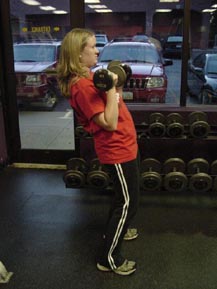
The pictures below depict a biceps curl in a manner that most of you probably
have never seen. Doing curls while kneeling helps to greatly reduce momentum
during the exercise. Even while doing a very strict standing dumbbell curl
your body is assisting in completing the movement.
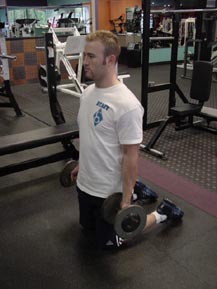
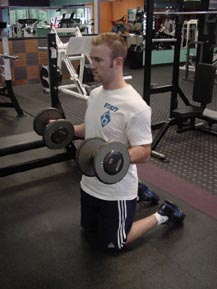
7. You should warm
up before every workout.
Properly warming up is vital to the success of your training sessions. By
warming up, you're getting your body ready to perform the tasks at hand.
Starting a workout cold will not only decrease your performance, but invites
injury.
A warm up can be as simple as walking at a moderate pace on the treadmill.
I like to dynamically warm up. In other words, I like to warm up using the
particular exercises I'm going to be performing in that particular workout.
I will do three to six warm up sets before performing my "work" sets.
The number of warm up sets I do depends on the size of the body part I'm
training that day. Just remember that your warm up sets are not to be taken
to failure.
8. You should make
recovery your number one priority.
It never ceases to amaze me how many people are willing to train for months
and even years while experiencing no progress. Because most do not record
their efforts in a training log they waste time arbitrarily trying nonproductive
routines, many of which come from sources like MuscleMag, Muscle and Fiction
and a host of others. The result is months and even years of spinning their
wheels with little or no gains.
The fact is that anyone, no matter what their genetic make up is, can make
progress. Anyone can improve upon his existing physical condition. With the
proper training program and recovery you can make steady progress every workout.
Yes, every workout.
Most people spin their wheels because they do too much. If performing three
sets per exercise doesn't yield the results they want the average person
will try four or more sets. I want all of you to throw out the "more
is better principle" right now. If you're not making progress, you're
not recovering. Doing more will only worsen the problem. Without keeping
a log you will never be able to accurately tell how you adapt to different
training stimuli.
Although we are basically the same physiologically, we react differently
to different training stimulus. Some of us recover very quickly and can use
a high volume of training. Some of us recover slowly and need to use a low
volume approach. It is our inherent differences that make designing programs
such a challenge.
There are two problems coaches and trainers are confronted with when designing
programs. No matter how meticulously and carefully you design the program,
it may not work for everybody. This is the first problem. Secondly, when
a program does work, it will only work for so long. Knowing when and how
to change your program is key. And without accurate records of what you've
done, how do you know what to try?
9. You shouldn't scream
while training in a gym.
Not only do you look and sound like an idiot, you're wasting valuable energy.
If you are one of these screaming asses learn how to focus your energy. Visualize
yourself performing the lift and then channel the energy to do the task.
Ed Caon, a multi-world record holder and arguably the number one powerlifter
ever, attributes much of his success to his ability to focus his energy.
10. You should visualize
your goals.
Your mind can be your greatest asset on your road to improving your physique.
You must use it to visualize the goals you want to attain. You must also
be able to imagine how you'll feel attaining these goals.
I once told someone that I, like so many others, would like to someday own
a Corvette ZR1. He asked me if I knew where the cigarette lighter was located.
I said no, with a perplexed look on my face. In response to my answer he
said that if I truly wanted that car and made it a goal of mine that I would
know where the cigarette lighter was located.
The concept of visualization seems odd to some. However, many successful
people including top athletes use some sort of visualization to attain their
goals. The mind must travel there first so that the body can follow.
Write your goals down on pieces of paper and post them in plain sight to
be constant reminders. Put them in your car, on your refrigerator and on
your bathroom mirror. Don't worry about others seeing these reminders. Announcing
your goals is another facet of the visualization process. If you're embarrassed
about your goals than you don't really want them. I think that you'll be
pleasantly surprised to find out that many people who know about your goals
will become a support system.
Got a question for Mike? Send it to mike@bullz-eye.com.
You can follow us on Twitter and Facebook for content updates. Also, sign up for our email list for weekly updates and check us out on Google+ as well.







